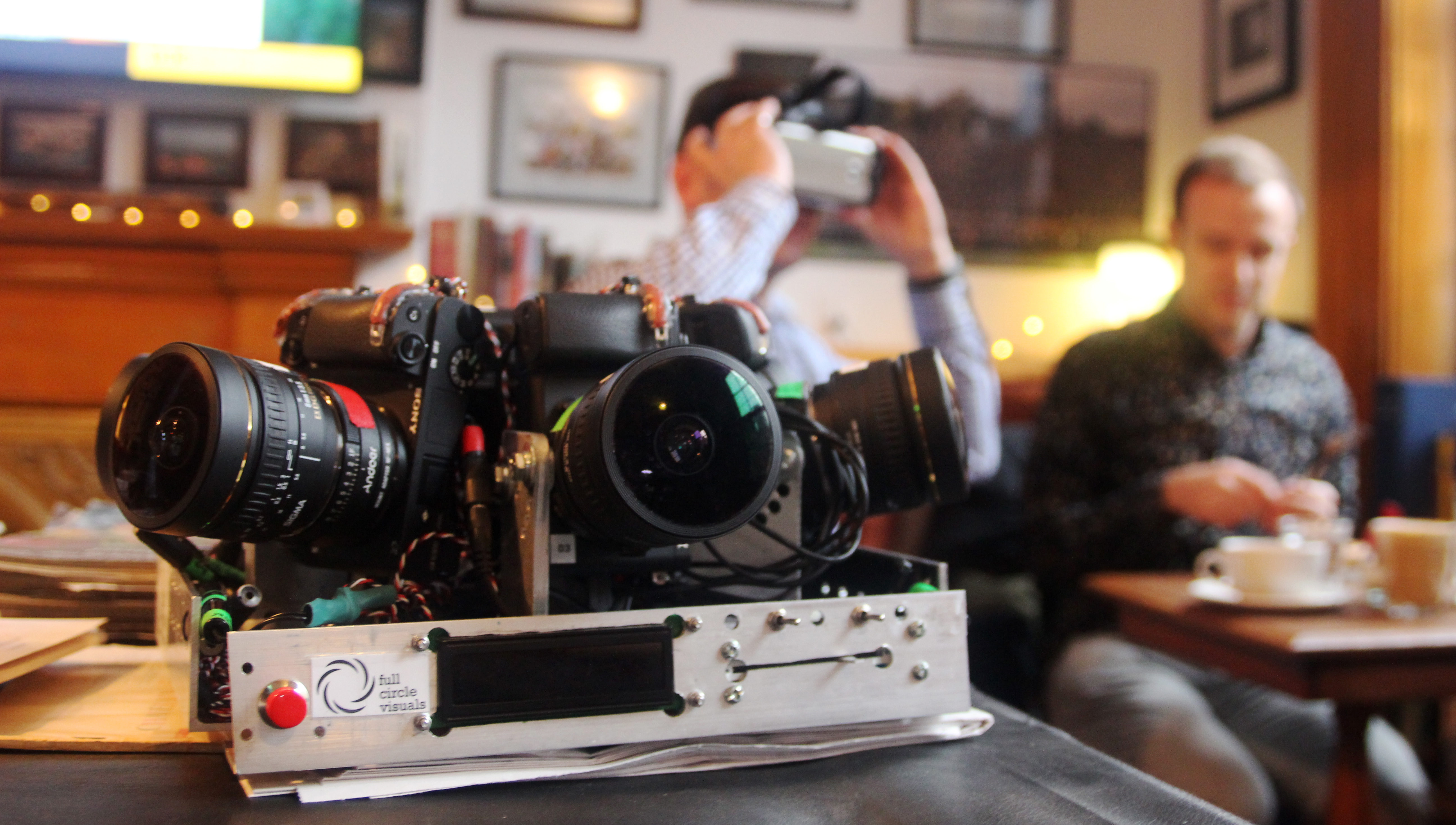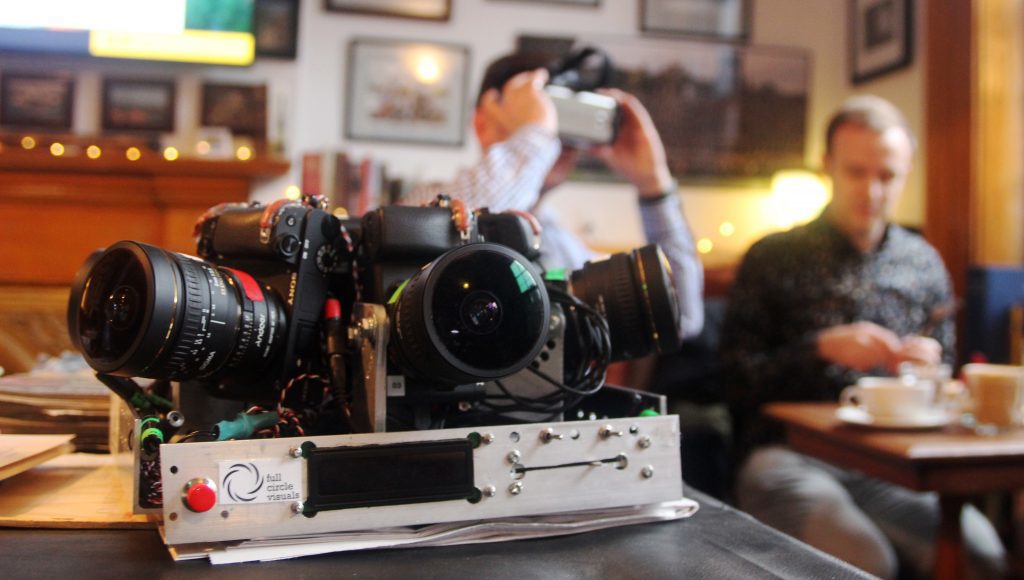
It’s a cold day in downtown Edmonton. There’s an unofficial wake for the deaths of Postmedia jobs being held at the Hat, a pub on Jasper Avenue close to the Edmonton Journal’s office. Ex-employees drift in and out. After months of mounting debt and financial despair, the company merged several newsrooms—like the Journal and the Edmonton Sun—and laid off 35 people in Edmonton and dozens of others across Canada. Ryan Jackson, a multimedia photojournalist and 360-video pioneer who’d been with the Journal for almost nine years, is one of the mourners. His mentee Samuel Brooks, who got a job with the Post because of a reference from Jackson, is not.
The window of Brooks’s ground-floor office in the Journal building faces the street. “I’m watching the parade of smarter, more talented people than me walking out with boxes of their desk stuff, and it’s hard not to burst into tears watching that,” he says. “There was all of this tension—it was just not a good place. It was a very big feeling of survivor’s guilt.”
That was on Jan. 19, 2016, or what Brooks later calls “Black Tuesday.”
“Or the Great Postmedia Purge,” offers Jackson.
“The first Great Postmedia Purge,” Brooks says.
We’re sitting at Cafe Melbourne on a rainy Toronto morning, nine months after Jackson’s last day at Postmedia. It’s also the day after the company has reported its fourth-quarter results for 2016, announcing that they’ll seek to reduce salary expenses by another 20 percent. “It’s been beyond the bone, and it’s just sucking out marrow now,” Jackson says.
“The first month [after the layoffs] was just a cloud,” he recalls. Severance was three weeks for every year worked, which in his case added up to six months. It was a bunch of time and a bunch of money, and the perfect opportunity—a release from what he calls the “velvet handcuffs” of a comfortable job—to pursue what Jackson had been working on for six years: 360-video production.
Jackson’s first 360 rig—like most other rigs nowadays—was several GoPros in a circle.
So he and Brooks founded the company Full Circle Visuals. When I met them, they were enjoying their last day in Toronto, having been flown in to teach Rogers (Maclean’s, Sportsnet, and CityTV) about 360 videos. The goal of their startup is to make cinema-quality 360 videos for Virtual Reality (VR) and dome projection—teaching newsrooms and shooting other types of video are a means to an end. “In many ways, we’re a gun for hire … Ryan loves to throw this pun in: ‘We offer a full circle of services,’” Brooks says. “[But] our interests are in 360, and doing it well and doing it beautifully.”
Jackson and Brooks agree that there have been two true tipping points for 360. The first was the introduction of the compact GoPro video camera in 2004, which remains the most popular camera for 360 shooting, Jackson says. The second watershed moment was a decade later, with the $2-billion acquisition of Oculus VR (developer of the Oculus Rift) by Facebook. Now, the Facebook algorithm seems to prioritize (and popularize) Mark Zuckerberg’s investment; you can hardly scroll through your timeline without seeing 360 videos.
Jackson’s personal foray into professional 360-video production was practically on a dare. The University of Alberta had held a record-setting dodgeball game in 2010, and Jackson’s video for the Journal had gone viral with a million views.
[su_quote]The next year , the university was going to set a world record again, and my wife was like, ‘Well how are you going to top last year?’ I was like, ‘Well I’ll show you!‘[/su_quote]That’s why Jackson shot 2011’s video in 360.
Though he’d experimented with still-panoramas and time lapses before, he’d never faced the pressure of shooting news in 360. Dodgeball was the perfect opportunity. Essentially, 360 videography and photography disrupt the notions of the traditional frame. “The important thing for 360 video is that it doesn’t work for everything,” Jackson says. Think of a press conference: If you shot a panorama of a media scrum, you’d be wasting 340 degrees—a traditional frame is all that’s needed. That framing allows you to hide most of reality and zoom in on a specific subject. “In 360, you can’t hide,” Brooks adds. “You can make a very big accountability argument.”
Frames aside, Jackson says 360 videos are actually an old idea. The 360 O’ Canada film at the Epcot pavilion in Walt Disney World, for example, has been running since the ‘80s. “You can find old-timey drawings of 360 film cameras, with like a man cranking a gear and then the gear turns six gears and turns all these cameras,” he says. “It’s not anything new, but only in the last five years has the cost come down enough that it’s becoming commonplace.”
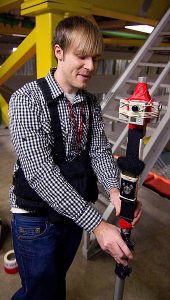
Courtesy: Farnia Fekri.
Jackson’s first 360 rig—like most other rigs nowadays—was several GoPros in a circle. Even then, he says, there were only a handful of 360 videos on the internet. And if videos were rare, then instructions on how to actually make 360 videos were nonexistent (at least in the English-language Internet). Having had to figure it out on his own, Jackson wanted to better the learning curve for others; he typed out a how-to manual after putting out the dodgeball game video. “I posted a step-by-step tutorial: here’s how I shot it, here’s how I synced the footage, here’s how I stitched it together. Here’s the software I used and here’s how much it cost. I post it on my website and I’m like, ‘Finally, it’s out there!’”
Within two hours, Jackson’s phone was ringing. A stranger on the other side said he was shocked that Jackson had shared his secrets and asked him to take it down. “He’s like, ‘I’ve been shooting 360 projects. People are offering me money to buy my workflow. You just put my workflow up on the internet for free.’”
But the post stayed up on www.punkoryan.com (a play on Punk-O-Rama and a tribute to the punk scene, where Jackson got his start as a photographer in Saskatoon). “I don’t want to take credit because I’m sure there are other people out there who did it, too,” he insists. But to this day, people approach him to say that they remember his contribution. “[Making 360 videos] is still very complicated … but the barrier of entry has never been lower and it’s getting lower and lower every day.”
***
Calling 360-video production “still complicated” is an understatement. As an ex-photo editor, I’m familiar with camera equipment, but Full Circle Visual’s homemade 360 rig makes my head spin. The current rig looks very DIY, a mass of metal and wire, but it’s practical: six Sony a6300 cameras run from the same sensor and battery and, if better cameras are released, Brooks tells me, new bodies can be easily swapped in. “You have no idea how good at soldering I’ve got lately,” he says. (Conveniently, both Brooks and Jackson studied engineering in university. Jackson dropped out to pursue photography while Brooks got the degree, “Like a shmuck,” Jackson says.)
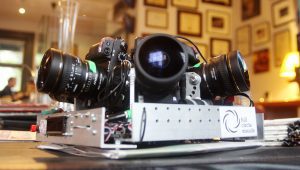
Courtesy: Farnia Fekri.
They don’t use GoPros because, as traditional photographers, they crave the control and quality of professional equipment. Every single piece of machinery—especially the Sigma 8mm fisheye lenses—was chosen after a lot of product testing. Brooks talks about Nikon mounts, mechanical control and lenses “talking to the body.” The a6300’s “beautiful sensor” and low-light performance are very impressive (apparently).
When they go shooting, they snap the rig onto a sturdy tripod. Sometimes, they walk away; other times (say, at Niagara Falls) they blend into the crowd. Or they’ll have to sit underneath the (very expensive, very steal-able) equipment, hiding from the all-seeing eyes of the 360 rig. “I’ll just sit underneath it and look around at people and wave at them,” Brooks says. “It’s weird and it’s funny, and it’s becoming a running joke on my Snapchat that I take so many selfies sitting underneath the tripod.”
The audio is recorded separately (a quality issue, I’m told) with a Zoom H6. Then everything gets dumped into a stitching program; there are several that can blend 360 video, but the term is quite literal. Six “normal” frames (from six cameras) must be stitched together into a panorama, which looks more like an LSD trip than a coherent visual when laid flat. “It’s 360 that you’ve taken an iron to, and flattened it out. It’s just a big rectangle,” Brooks explains. Now you do what any good video editor (and any editing program, like Premiere or Final Cut) can do: colour balance, cleanup, transitions, titles, tracks. You can even save in MP4s—the only differences are the huge file size and super high-resolution of the video.
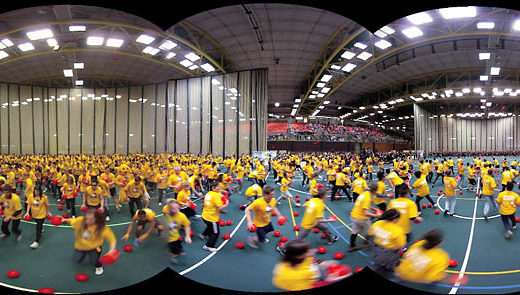
“Stitching is a headache,” Brooks admits. But the hardest part is syncing the cameras together. You can use a loud noise, a burst of light or motion detection. Their preferred method is cheap and cheerful: a dog-training clicker.
Its sharp snap is more reminiscent of toy guns. Brooks waves the yellow, thumb-sized device in my face. “It’s not muddy like a clap. It’s very crisp,” he says. “Sometimes the thing you buy for a dollar is the most simple solution.”
Once the footage is synced, shot, stitched, fitted with audio and edited, it’s ready. Brooks and Jackson carry around a white Samsung Gear VR (Brooks’ phone snaps into the front) for clients to watch their demo reels. “It’s nice and simple,” Brooks says. He fits the headset on my head. Dodgeballs, Slave Lake, Las Vegas and the Toronto Distillery District fly in front of my eyes. At Kensington Market (in Toronto) I catch a glimpse of Brooks, dutifully sitting under the tripod. With Writing-on-Stone Park comes the whistling of the wind, the solitude of a lonely and expansive landscape, the intense gaze of the Alberta sun. By the time I slip the headset off, I’ve halfway fallen out of my chair.
***
After the success of the dodgeball video, Jackson continued to work on 360 videos for the Journal. He did a project on the devastating wildfires of Slave Lake, Alberta, by strapping a 360 rig to the top of a van. Displaced townspeople used it to check on their streets, he says. A year later, they recreated the video and drove through the town again to do a 360 before-and-after. Then he tried to tackle an eternal question: how do you make provincial election campaigns interesting to the public? His answer was a 360 video/interactive hybrid that was stitched to make it seem like the viewer was sitting for coffee with the candidates. They could click on questions and hear individual answers. It changed the idea of 360 video from just a “spectacle” that was “neat,” into something more.
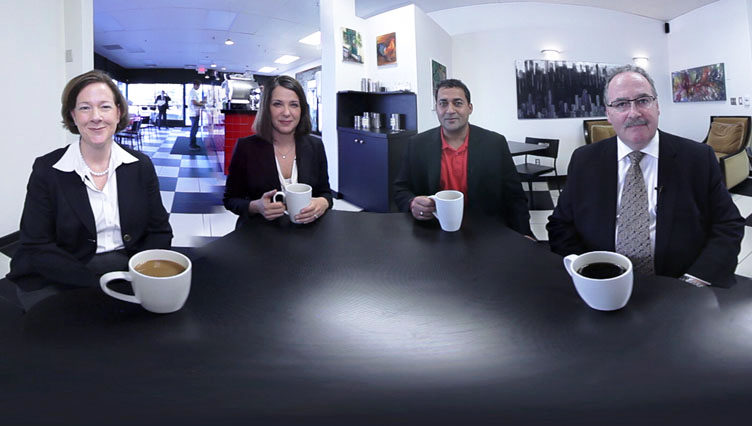
But at around the same time, the culture of creativity at the Journal was fading fast. Encouraging bosses who truly put digital first were drifting in and (more often) out. He began to realize where his job was headed and spent thousands of dollars—”investing” in himself, he says—on 360 equipment and software. He even tried his hand at a 360-video startup, but the project fell apart. By 2014, Jackson says he didn’t have the time to work on any 360 projects for the Journal. “We could see the ridiculous canyon between the rhetoric of a company saying ‘Digital first!’ and what they actually did,” he told me. “Postmedia was actually making it harder to be innovative. They were creating more bureaucracy on the website. It was like, 80 percent of my job was trying to do my job.”
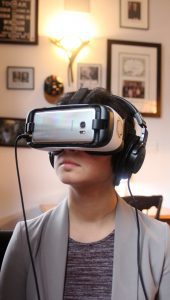
Courtesy: Farnia Fekri.
Though Brooks and Jackson have followed similar trajectories (engineering students accidentally sucked into photography and the student press), they couldn’t be more different in person. Jackson is soft-spoken and talks in long-winded arcs. Everything about Brooks is loud, from the perfectly parted hair to the booming laugh. The contrast works especially well for their company. “He’s the innovative brains behind this,” Brooks says of Jackson. “All the things that he hates doing—filling out tax forms and making projections on spreadsheets and dealing with accounts payable and all that kind of stuff—I don’t mind doing. I spend days in the garage building camera rigs, and then I spend days in the field shooting, and then I spend a lot of time in the office just doing the administrative work and business development.”
That (the “smart cookie” factor, Jackson calls it) is partly why he approached Brooks—who was still at the Journal—within a month of being laid off. Full Circle Visuals was incorporated at the beginning of March, and then they decided on the day that Brooks would leave Postmedia: May 31. “There was this conference in Montreal that was all about VR and was actually really focused on immersive audio,” Brooks recalls. “I flew to Toronto, I handed in my gun and badge to Postmedia Headquarters, and then I got on the train to Montreal.” By July 22, on a warm Friday evening, the two were back at the Hat, in Edmonton. In the wood-and-leather bar that had nursed the mourning Postmedia group months before, Jackson and Brooks brought much of Black Tuesday’s crowd back together for Full Circle Visual’s launch party.
